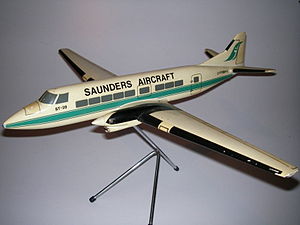Saunders ST-27 Video - Picture

|
|
Saunders ST-27
Saunders ST-27

Picture - Saunders ST-28 factory "desk" model
Role: Airliner
Manufacturer: Saunders Aircraft Company
Designed by: David Saunders
First flight: May 28, 1969
Retired: 1980s
Primary users: Air Atonobee
Aerolineas Centrales de Colombia
Produced: 1969-1976
Number built: 12
Developed from: de Havilland Heron
The Saunders ST-27 regional airliner was built in the 1970s by the Canadian Saunders Aircraft Company in Gimli, Manitoba, Designed as a conversion of the earlier de Havilland Heron, the ST-27 was the most radical DH Heron conversion program, featuring two Pratt & Whitney Canada PT6 turboprops and a stretched fuselage. Despite its promise as a regional airliner, the project collapsed when Manitoba government funding was withdrawn.
Design and development
Using 13 surplus de Havilland Herons, Saunders created a conversion with some engineering input from Aviation Traders (Engineering). The remanufactured design was based on a stretched fuselage to accommodate 23 passengers, a lengthened nose to fit a radar, reshaped vertical tail (also increased in size) and two Pratt and Whitney PT6A turboprops replacing the original four Gipsy Queen piston engines, along with other minor changes.
Operational history
Originally based in Quebec, the Saunders operation moved to Manitoba in 1971 when substantial government start-up funding was obtained. The Manitoba government eventually invested $52 million (Canadian) until 1976. Only 12 ST-27s were built. Although the improved performance of the turboprops was appreciated by prospective customers, the lack of a US certification limited potential sales. Two Saunders ST-27s were dry-leased to "Sky-West" in order to provide scheduled air service to Yorkton, Dauphin and Brandon (from Saskatoon and Winnipeg) as an economic development project. Other ST-27s served as regional airliners in Ontario and elsewhere but few air carriers were exploiting this route system at the time. The notable exception was Air Atonabee operating scheduled passenger service from the Island Airport (Toronto), using ST-27 aircraft beginning in 1974; by 1984, it was carrying 25,000 passengers annually.
Saunders ST-28
With only meager sales success due to the certification issue and with old Herons becoming more expensive, the company decided to manufacture a new version based on the original ST-27, compliant with US Federal Aviation Regulation Part 23 (FAR 23). The first ST-28 was manufactured at the Gimli, Manitoba factory using new jigs and tooling supplied by Hawker Siddeley Aviation. Although superficially similar to the earlier ST-27, the new aircraft benefited from the experiences flying the earlier airliner in regular service. Larger cabin windows, an increased rudder size, four-bladed propellers and a host of other enhancements were incorporated in the ST-28, including a 1,000 lb (450 kg) increase in maximum take off weight (MTOW) and extra fuel capacity. The first flight of the prototype, C-FYBM-X took place on July 18, 1974.
While testing was taking place towards an American certification, the Saunders company had plans for series production but no firm orders and a tremendous drain on available funding. The precarious financial situation eventually led to a review by the Manitoba government and the withdrawal of funding in 1976. The company was forced to wind down operations and sold all assets and rights to Air Otonobee, one of the primary operators of the earlier ST-27. By the early 1980s, the sturdy airliners began to fade from service with the last ST-27 being retired during this period.
Aftermath
C-GCML (cn 009) was converted from DH Heron c/no. 14095 in 1974 and is now on display at the Canadian Bushplane Heritage Centre, Sault Ste Marie, Ontario, Canada. The ST-28 prototype is still found at Gimli in a derelict and abandoned condition in a reclamation yard owned by the Western Canada Aviation Museum.
Operators
Barbados
Tropical Air Services
Canada
Air Atonabee (Otonabee Airways) - City Express
Atlantic Central Airlines
Bayview Air Service
Bearskin Lake Air Service
Labrador Airways
Northward Aviation
On Air
Patricia Air Transport
St. Andrews Airways
Voyageur Airways
Colombia
Aerolinas Centrales de Colombia - ACES Colombia
Specifications for Saunders ST-27
Data from Jane's All The World's Aircraft 1971-72
General characteristics
Crew: 2
Capacity: 24 passengers
Length: 58 ft 10 in (17.93 m)
Wingspan: 71 ft 6 in (21.79 m)
Height: 15 ft 7 in (4.75 m)
Wing area: 499 sq. ft (46.36 m²)
Aspect ratio: 10.3:1
Empty weight: 7,600 lb (3,447 kg)
Max takeoff weight: 13,500 lb (6,124 kg)
Powerplant: 2x— Pratt & Whitney PT6A-27 turboprops, 715 hp (533 kW) each
Performance
Never exceed speed: 292 mph (253 knots, 470 km/h)
Cruise speed: 230 mph (200 knots, 370 km/h) at 7,000 ft (2,135 m) (Max cruise)
Stall speed: 70 mph (61 knots, 113 km/h) (flaps down)
Range: 852 mi (740 nmi, 1,370 km)
Service ceiling: 25,000 ft (7,620 m)
Rate of climb: 1,600 ft/min (3.0 m/s)
Bibliography
Gerritsma, Joop. "The Saunders ST-27: A Prop-Jet Commuter Liner by Conversion." Canadian Aviation Historical Society - Journal, Vol. 35, No. 4, Winter 1997.
Molson, Ken M. and Harold A. Taylor. Canadian Aircraft Since 1909. Stittsville, Ontario: Canada's Wings, Inc., 1982. ISBN 0-920002-11-0.
Taylor, John W. R. Jane's All The World's Aircraft 1971-72. London: Sampson Low, Marston & Co., 1971. ISBN 0 354 00094 2.
Saunders ST-27 Pictures
More airplane videos.
Source: WikiPedia